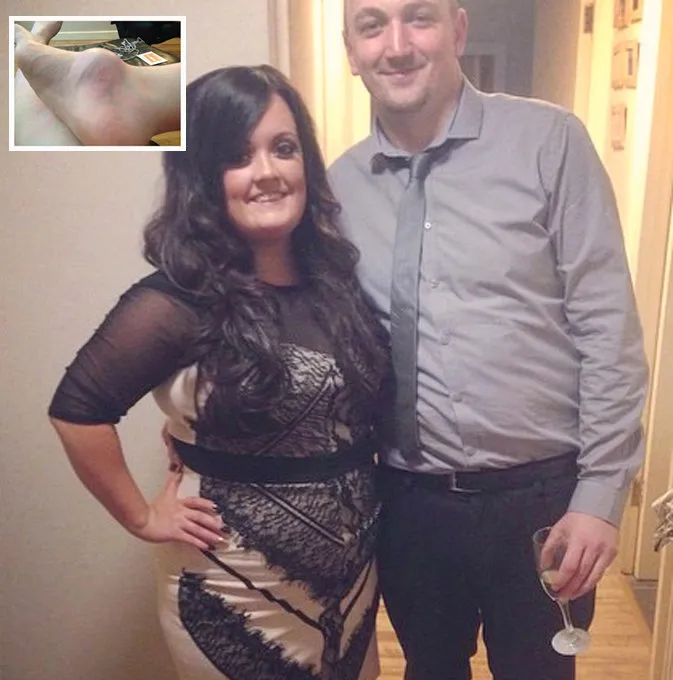Cheryl Murray lived with a painful, growing growth on her foot for ten years. She was embarrassed and withheld it from her partner for two years. After they moved in together, the bulge, which was now the size of a golf ball, could no longer be concealed. Just in time, he advised her to get it checked out as well.
As it happened, the bump was cancer. Murray first noticed the sore lump growing on her foot when she was just 15 years old. When she saw her doctor, he suggested that she start physical therapy.
They suspected she had torn a ligament after she fell and slipped. However, the lump became considerably larger during the next ten years. It hurt so much that when something bumped it, it grew to the size of a golf ball.

Cheryl Murray lived with a painful, growing growth on her foot for ten years. She was embarrassed and withheld it from her partner for two years. After they moved in together, the bulge, which was now the size of a golf ball, could no longer be concealed. Just in time, he advised her to get it checked out as well.
As it happened, the bump was cancer. Murray first noticed the sore lump growing on her foot when she was just 15 years old. When she saw her doctor, he suggested that she start physical therapy.
They suspected she had torn a ligament after she fell and slipped. However, the lump became considerably larger during the next ten years. It hurt so much that when something bumped it, it grew to the size of a golf ball.

After that, she began dating David, who is currently her spouse. She felt embarrassed by it, so she kept it from him. It wasn’t until they moved in together that she realized she couldn’t keep up the front. When she showed him the bulge, he suggested she maybe go back to the doctor for an explanation.
“David asked me what was wrong with my foot. I replied that it was torn ligaments, but he could tell it wasn’t, that it was more serious,” she recalled
The Day Everything Changed.
Murray saw her physician, who recommended an X-ray, biopsies, and an MRI. A surgeon then gave her an explanation of the findings and the two unwelcome news that no one ever wants to hear: It was cancer, a sarcoma, that she had. They would need to amputate her lower leg as soon as possible to prevent the malignancy from spreading.
“I was hysterical. I was so stunned I couldn’t speak,” Murray said. “I felt like I had been punched in the face twice on one day.”
She was dating David, and he was by her side the whole time. He’d even popped the question to her a few weeks before her amputation. Murray claims that she credits him with helping her survive the circumstance. He gave her the drive and determination to carry on.
Sarcoma of the connective tissue is a rare kind of cancer that affects soft tissue, including muscles, tendons, and fat. It might also affect the body’s blood vessels, bones, cartilage, neurons, and other tissues.
Cells in the connective tissue that envelops bones, muscles, and other connective tissues give rise to tumors known as sarcomas. They are not the same in terms of locations or external characteristics. Sarcomas can originate in any part of the body, but most typically begin in the arms or legs.
What Causes Sarcomas?
These cancers are more common in adults than in children, while it is unclear where they exactly originate. Furthermore, those who have received radiation therapy or chemotherapy for prior tumors are at a higher risk of developing them.
The three most common types of bone sarcomas are osteosarcoma (bone cancer), chondrosarcoma (cartilage cancer), and Ewing’s sarcoma (bone marrow-derived cancer). Most patients are between the ages of 15 and 30 when these tumors are detected. Adults are more likely than children to develop osteosarcoma, and the risk increases with age.
What Are The Symptoms?
The location of the tumor may affect the symptoms that manifest. There may be a lump or mass under your skin, as well as pain or swelling in one or more bodily parts. The most common symptom is pain, which can range in intensity from mild to severe. Extra indications consist of:
- Swelling in one area of your body (especially if it does not go away)
- Bone deformity (such as a lump or bump on your bone that does not go away)
- Weakness in one part of your body (such as an arm or leg)
- Difficulty walking or moving around
- A change in the way you walk
- Loss of muscle mass and strength

Murray was incredibly lucky to have escaped her illness and to have been able to plan her wedding to the love of her life. This event is another reminder to get help anytime you feel like there might be an issue or if you are in constant pain or suffering.
If the answers don’t seem correct or helpful to you, keep looking. Act as your own greatest advocate and get the help you need. Your life could be in jeopardy.